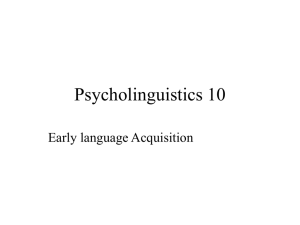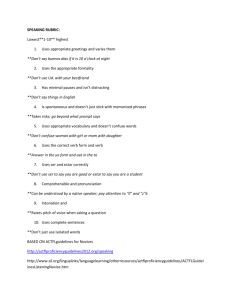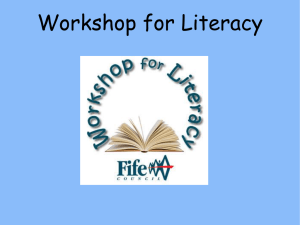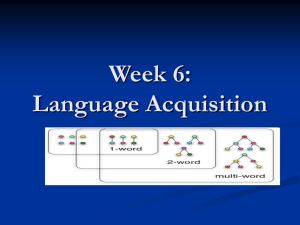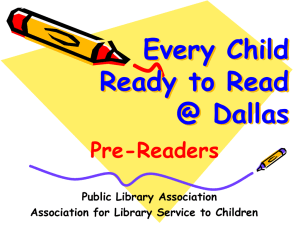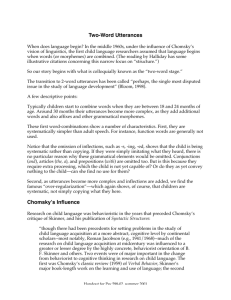Chapter 2 Normal Language Development A Review Objectives The
advertisement
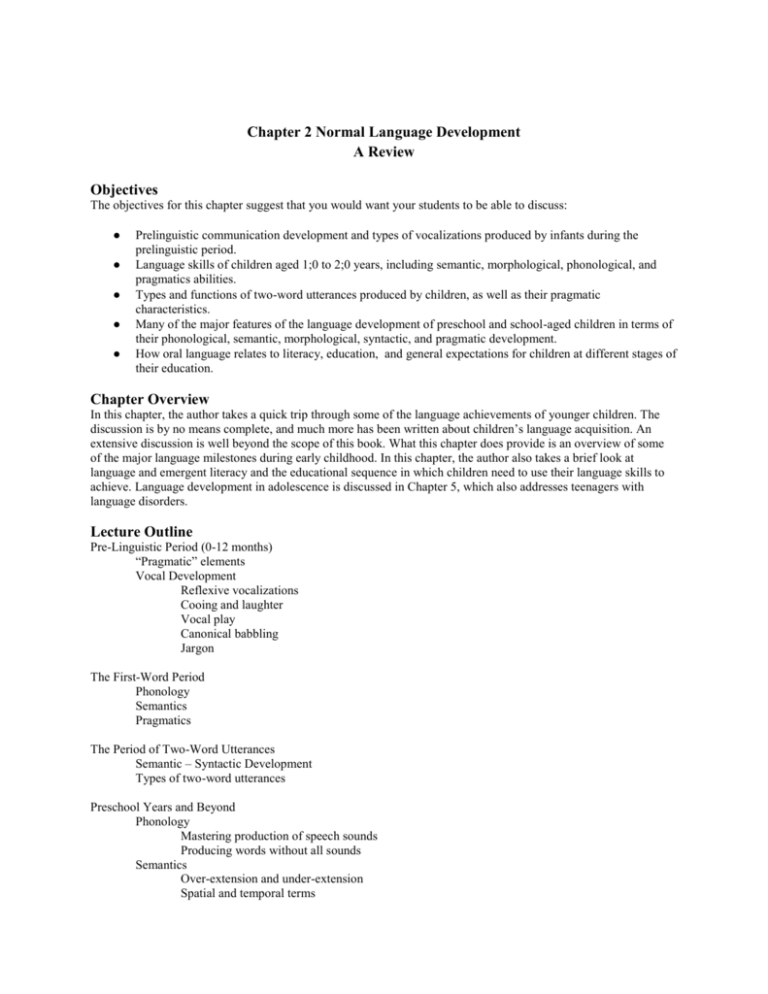
Chapter 2 Normal Language Development A Review Objectives The objectives for this chapter suggest that you would want your students to be able to discuss: ● ● ● ● ● Prelinguistic communication development and types of vocalizations produced by infants during the prelinguistic period. Language skills of children aged 1;0 to 2;0 years, including semantic, morphological, phonological, and pragmatics abilities. Types and functions of two-word utterances produced by children, as well as their pragmatic characteristics. Many of the major features of the language development of preschool and school-aged children in terms of their phonological, semantic, morphological, syntactic, and pragmatic development. How oral language relates to literacy, education, and general expectations for children at different stages of their education. Chapter Overview In this chapter, the author takes a quick trip through some of the language achievements of younger children. The discussion is by no means complete, and much more has been written about children’s language acquisition. An extensive discussion is well beyond the scope of this book. What this chapter does provide is an overview of some of the major language milestones during early childhood. In this chapter, the author also takes a brief look at language and emergent literacy and the educational sequence in which children need to use their language skills to achieve. Language development in adolescence is discussed in Chapter 5, which also addresses teenagers with language disorders. Lecture Outline Pre-Linguistic Period (0-12 months) “Pragmatic” elements Vocal Development Reflexive vocalizations Cooing and laughter Vocal play Canonical babbling Jargon The First-Word Period Phonology Semantics Pragmatics The Period of Two-Word Utterances Semantic – Syntactic Development Types of two-word utterances Preschool Years and Beyond Phonology Mastering production of speech sounds Producing words without all sounds Semantics Over-extension and under-extension Spatial and temporal terms Deictic words Morphology Brown’s morpheme development Other forms – comparative, superlative, noun/adverb derivations and prefixes Syntax Expanding two-word utterances Acquisition of negatives Acquisition of questions Acquisition of compound and complex sentences Pragmatics Functions of language Presupposition Turn-taking, topic maintenance and revisions Fluency Narratives Metalinguistics Language, Literacy, and Education Emergent and Preliteracy School Elementary grades Secondary grades Key Terms Prelinguistics Illocution Locution Prelocution Phonological Processes Fast Mapping Mazes Narratives Emergent literacy or Preliteracy Topics for Discussion 1. What are the accompanying motor, cognitive and social developments that occur during the pre-linguistic period? What environmental factors might come in to play? What impact does this have on speech development in the infant? 2. What role does shared storybook reading play in literacy development? What cultural and socio-economic factors might be involved? 3. What are some of the federal education initiatives that have been put into place in the last ten years to improve literacy development? What role does the speech-language pathologist play in those initiatives? Learning Activities 1. Provide students with the checklist based on Table 2.2. Show students an appropriate video of a child in the one-word stage and ask them to write down any utterances the child has which correspond to each type of Lahey's (1988) relational words. Discuss student examples in class. 2. Having discussed both Bloom's (1970) and Brown's (1973) semantic relations in class, provide students with the following word list and ask them to combine these words in as many different two-word combinations as they can. Then have students exchange lists with another pair of students. Ask each student to classify each two-word combination against each possible semantic relation. Word list: doggie, ball, no, more, nigh-nigh, gone, here, my, mommy, juice. 3. Provide students with two language transcripts from a child in the three-four word utterance range. Use the first language sample to demonstrate calculating both mean number of words and mean length of utterance (MLU). Discuss the value of each calculation. Ask students to calculate MLU on the second language sample. Discuss their results in class. 4. Present students with a number of story books for preschoolers which are well known to your students (e.g., Goldilocks, Winnie the Pooh, or The Cat in the Hat). Ask students to determine which narrative structure each story contains and to identify the story elements contained therein. 5. Prior to class, assign a debate question and ask all students to prepare both sides of the question. On the day of the debate, divide the class into groups of 6-8 students. Assign each group as “pro” or “con” and allow 15 minutes for the groups to prepare. Follow a traditional debate structure. Suggested topic: “The school system is responsible for literacy development.” 6. Require students to develop and create materials aimed at teen mothers to promote the speech, language and literacy development of their infants. Explanations, images, and materials should be appropriate to the audience (teen mothers). Exam Questions Multiple Choice 1. "ba da na" is an example of ___________ babbling. a. cooing b. variegated c. reduplicated d. iconic 2. In semantic development, “mama” applying to all women is an example of: a. over-extension b. under-extension c. non-reduplicated babbling d. substitution 3. The final stage of speech act development is known as the: a. locutionary period. b. illocutionary period c. perlocutionary period d. logistical period 4. Deictic words are: a. present in Brown’s Stage 1 b. terms that have changing referents c. always nouns d. temporal in nature 5. When do metalinguistic skills develop? a. during the prelinguistic period b. beginning at age 7-8 years into adulthood c. in conjunction with the emergence of turn-taking d. Brown’s Stage 1 Multiple Choice Key 1. b. 2. a. 3. a. 4. b. 5. d. Short Answer/Essay 1. What defines a true first word? 2. The development of two-word utterances is not haphazard. List three ways in which it is developed? 3. Calculate the MLU of the following utterances: Doggie runned away. More juice please. Baby up. Juice all-gone. Johnny painting doggie. 4. Write three utterances which might be typical of a three year old child and indicate the features of these utterances. 5. Define a phonological process. 6. In semantic development, what is meant by over-extension and under-extension? 7. Explain what is meant by “fast mapping is a lexical acquisition strategy”. 8. How do young children vary their use of definite and indefinite articles? 9. Describe some of the devices used by children to maintain topic in conversation. 10. Which two aspects of oral language appear to be related to the development of metalinguistic skills? 11. List the factors associated with a child's environments that promote literacy. 12. List and briefly describe Applebee's six levels of narrative. Short Answer Key 1. A true word is one in which it is used consistently in a specific context, and has a recognizable phonetic form. 2. Children demonstrate these skills as they approach the two-word stage: (a) an increase in the number of verbs, (b) a reduction in other types of relational words, and (c) an increase in the number of object-class words used in their language. 3. Doggie runned away. – 4 More juice please. – 3 Baby up. – 2 Juice all-gone. – 2 Johnny painting doggie. – 4 15/5 = 3; MLU= 3 4. Possible features of sentences generated by the students may include: MLU of 1.5, words characterized by nasals, stops or glides, use of semantic relations (Table 2.4), and an absence of morphological endings on the words used (root words). 5. Phonological processes are children’s simplified pronunciation of words that follow patterns. These are natural and will remit as the child ages. 6. Overextension is when a child over-generalizes the meaning of a word (e.g., all four-legged animals being dogs), and underextension is when a child under-generalizes the meaning of a word so that the word’s meaning becomes too specific (e.g., bottle applying only to the baby’s bottle). 7. It can be termed lexical acquisition strategy because the child uses fast mapping to construct a representation for an unfamiliar word on the basis of a single exposure to it. They might form an initial representation containing information on the semantic, phonological, or syntactic characteristics of the new lexical item, as well as nonlinguistic information related to the situation in which it was encountered to help them more quickly learn a new word. 8. Three-year-old children randomly use either the definite or indefinite article for introducing initial referents. From three years on, there was an increase in appropriate use of the indefinite article for initial referents, but it is not until nine years of age that children demonstrate a true preference for using the indefinite article for initial referents. In contrast, adults consistently introduce initial referents with the indefinite article. 9. As children grow older, they increasingly add new information to a topic to maintain it. Before age 3, children tend to use focus/imitation topic maintenance devices. That is, they attend to one or more of the words in a previous utterance and repeat or imitate those portions in their succeeding responses. As children approach age 3, their use of focus/imitation devices decreases while their use of substitution/expansion operations increases. In substitution/expansion, children add information to the topic of a previous utterance or modify the previous utterance in some way. 10. Two aspects: (a) the ability to detect ambiguities in utterances, and (b) the intentional use of figurative language and jokes. 11. Some factors associated with a child's environments that promote literacy include: (a) a variety of print materials in the environment; (b) writing instruments (crayons, pencils) and paper easily available ;(c) adults who are responsive to the child’s attempts to read and write; (d) reading and writing as integrated and embedded activities in daily family routine as regular activities of living; and (e) adult–child storybook reading. 12. Applebee’s six levels of narratives include (from least to most complex): (a) Heaps - These are a series of unrelated, unsequential statements and are also called protonarratives. (b) Sequences - The information in sequences is presented in an additive but not temporal fashion. (c) Primitive temporal narratives - These narratives still do not contain plots or evidence causality; they do present information in a rudimentary temporal sequence and are focused around a central event. (d) Unfocused temporal chains - These contain concrete relationships chained in temporal order. (e) Focused temporal (causal chains) - Narratives of this type typically have a main character and events are presented in a chained manner around the character. Initially, events are chained in a temporal order. (f) Proper narratives - These not only have central themes and/or characters, but generally include multiple causal chains, as well as temporal organization. True/False 1. The sounds produced during the jargon stage are typical of the sounds found in first words. 2. The final stage of speech act development is known as the locutionary period. 3. During the one word stage, children exhibit greater speech accuracy in production of action words than object words. 4. Children learn the full rules of conversational turn-taking by their second birthday. 5. A typically developing child will have an expressive vocabulary of 50 words at around 18 months and up to 300 words at their second birthday. 6. The mutual exclusivity proposition suggests that a child will assume that a new word will apply to the object for which the child does not yet have a name, rather than any already known item. 7. Temporal prepositions are generally acquired before spatial prepositions. 8. Children begin to use grammatical morphemes when their MLU reaches about 3.0. 9. In typically developing children, regular noun plurals appear after present progressive verb endings. 10. Effective speakers ignore their presuppositions in order to communicate clearly. 11. True narratives have central themes, multiple focused causal, and temporal chains. 12. An important part of kindergarten is acculturating children to scripts and the routines of group instruction. True/False Key 1. True 2. True 3. False 4. True 5. True 6. True 7. False 8. False 9. True 10. False 11. True 12. True Supplemental Materials Books and Articles Hart, B & Risely, T.R. (1995). Meaningful differences in the everyday experience of young American children. Brookes Publishing. Lintott, M., & Hanen Centre. (2007). You make the difference: Parent-child interaction program. Toronto, ON: Hanen Centre. Rossetti, L. M. (2001). Communication intervention: Birth to three (2nd Ed.). San Diego; Singular-ThompsonLearning. Videos Child Development Media - This site offers various collections of videos for purchase. http://www.childdevelopmentmedia.com/child-language-development.html Weblinks The American Speech Language Hearing Association (ASHA)-This site provides a number of resources available for professionals and parents. http://www.asha.org/public/speech/development/ National Center for Infants, Toddlers and Families-This site offers a variety of resources for the pre-school population. http://www.zerotothree.org/ National Institute on Deafness and Other Communication Disorders (NIDCD)-This site provides information on developmental milestones including a number of checklists. http://www.nidcd.nih.gov/health/voice/speechandlanguage.html Vocal Development.Com-This site is designed to share information about early speech development and to provide examples of the speech sounds that children produce before they say words on a regular basis. http://www.vocaldevelopment.com/
